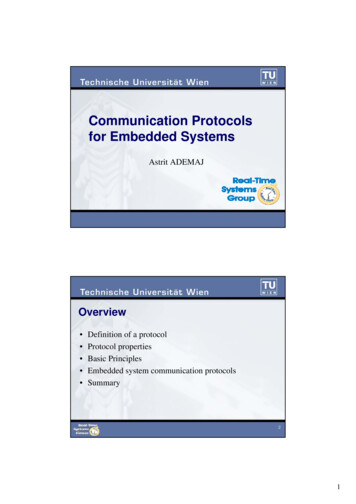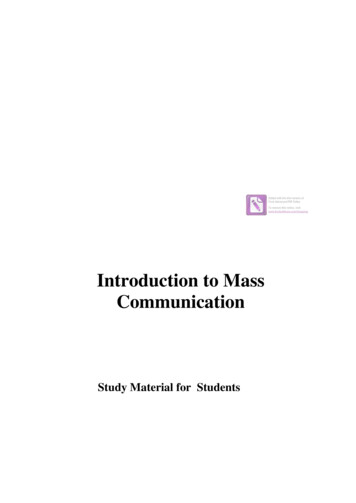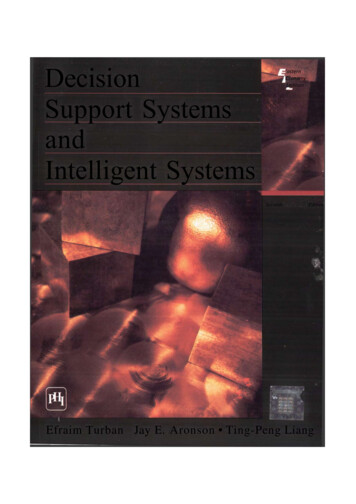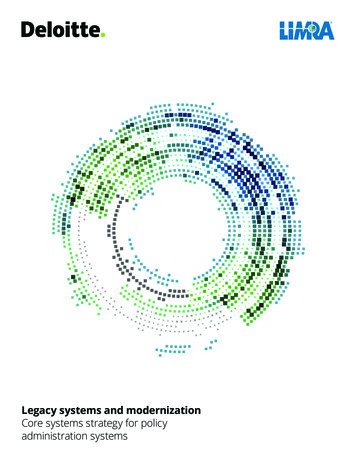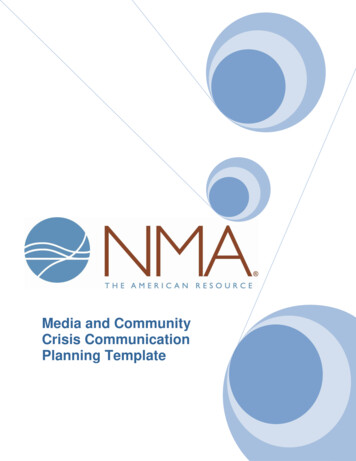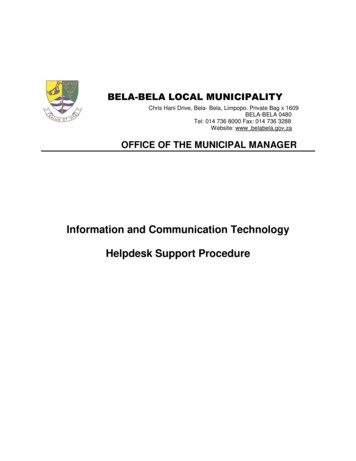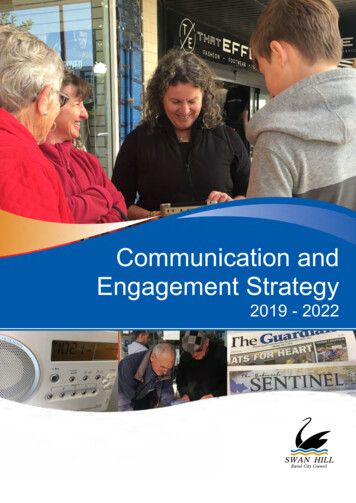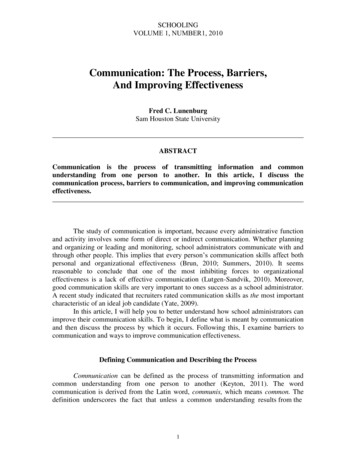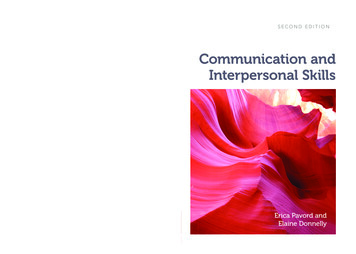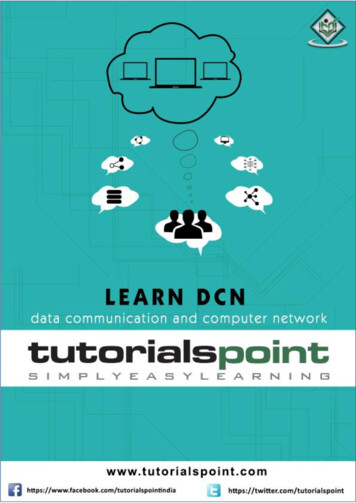
Transcription
Introduction toCommunication Systemsand NetworksDr. Farid FarahmandUpdated 8/31/2010
Telecommunicationsn Tele (Far) Communicationsn Early telecommunicationsn n smoke signals and drumsvisual telegraphy (or semaphore in 1792)n Telegraph and telephonen n Telegraph (1839)Telephone (1876)n Radio and televisionn Telephonyn Voice and Data
Communications and Networksn Data Communicationsn Transmission of signalsn Encoding, interfacing, signal integrity, multiplexing etc.n Networkingn Topology & architecture used to interconnect devicesn Networks of communication systems
Network Trends (1980-Present)Applications: Voice, Image, Data, ted Systems!
Communication Systemsn Process describing transfer of information, data, instructionsbetween one or more systems through some median Examplesn n people, computers, cell phones, etc.Computer communication systemsn Signals passing through the communication channel can beDigital, or analogn n Analog signals: continuous electrical wavesDigital signals: individual electrical pulses (bits)n Receivers and transmitters: desktop computers, mainframecomputers, etc.Communication channelCommunicationmediaR RR X XXTXAmp/Adaptor
Communication Systems
Communications Componentsn Basic components of acommunication systemn n n n Communication technologiesCommunication devicesCommunication channelsCommunication software
A Communications Model
Communications TasksTransmission system utilizationAddressingInterfacingRoutingSignal generationRecoverySynchronizationMessage formattingExchange managementSecurityError detection and correctionNetwork managementFlow control
Data Communications Model
Communication TechnologyApplicationsvoice wittertelephonygroupwarechat roomsvideoconferencingglobal positioningsystem (GPS)
Communication Technologies Applicationsn Different technologies allowing us to communicaten n n n Voice mail: Similar to answering machine but digitizedFax: Sending hardcopy of text or photographs between computers using faxmodemEmail: electronic mail – sending text, files, images between different computernetworks - must have email softwaren n n n Sends digitized audio signals over the InternetRequires Internet telephone softwareGroupware: Software application allowing a group of people to communicatewith each other (exchange data)n n More than 1.3 billion people send 244 billion messages monthly!Chat rooms: Allows communications in real time when connected to the InternetTelephony: Talking to other people over the Internet (also called VoIP)n n Examples: Voice mail, fax, email, instant message, chat rooms, news groups,telephony, GPS, and moreAddress book, appointment book, schedules, etc.GPS: consists of receivers connected to satellite systemsn n Determining the geographical location of the receiverUsed for cars, advertising, hiking, tracking, etc.
Communication Devicesn Any type of hardware capable of transmitting data, instructions, andinformation between devicesn n Functioning as receiver, transmitter, adaptor, converterBasic characteristics: How fast, how far, how much data!n Examples: Dial-up modems, ISDN, DSL modems, network interface cardsn Dial-up modem: uses standard phone linesn Converts digital information into analogn Consists of a modulator and a demodulatorn Can be external, internal, wirelessn ISDN and DSL Modem: Allows digital communication between networks andcomputersn Requires a digital modemn Digital is better than analog – why?n Cable modem: a modem that transmits and receives data over the cabletelevision (CATV) networkn Also called broadband modem (carrying multiple signals)n The incoming signal is splitn Requires a cable modemn Network interface cards: Adaptor cards residing in the computer to transmitand receiver data over the network (NIC)n Operate with different network technologies (e.g., Ethernet)
Communication Softwaren Examples of applications (Layer 7) take advantage of thetransport (Layer 4) services of TCP and UDPn n n n n n n Hypertext Transfer Protocol (HTTP): A client/serverapplication that uses TCP for transport to retrieve HTML pages.Domain Name Service (DNS): A name-to-address translationapplication that uses both TCP and UDP transport.Telnet: A virtual terminal application that uses TCP fortransport.File Transport Protocol (FTP): A file transfer application thatuses TCP for transport.Trivial File Transfer Protocol (TFTP): A file transferapplication that uses UDP for transport.Network Time Protocol (NTP): An application thatsynchronizes time with a time source and uses UDP fortransport.Border Gateway Protocol (BGP): An exterior gateway routingprotocol that uses TCP for transport. BGP is used to exchangerouting information for the Internet and is the protocol usedbetween service providers.
Communication Channelsn A channel is a path between two communicationdevicesn Channel capacity: How much data can be passedthrough the channel (bit/sec)n n Also called channel bandwidthThe smaller the pipe the slower data transfer!n Consists of one or more transmission median Materials carrying the signaln Two types:n Physical: wire cableT1linesdestinationn Wireless: AirnetworkserverT1linesT3linesT1lines
Physical Transmission Median A tangible mediaExamples: Twisted-pair cable, coaxial cable, Fiber-optics,etc.n Twisted-pair cable:n One or more twisted wires bundled together (why?)n Made of coppern Coax-Cable:n Consists of single copper wire surrounded by three layers ofinsulating and metal materialsn Typically used for cable TVn Fiber-optics:n Strands of glass or plastic used to transmit lightn Very high capacity, low noise, small size, less suitable tonatural disturbancesn
Physical Transmission Mediawoven orbraided metalplastic outercoatingtwisted-pair cablecopper wireinsulatingmaterialoptical fibercoreglass claddingprotectivecoatingtwisted-pair wire
Wireless Transmission Median Broadcast RadioDistribute signals through the airover long distancen Uses an antennan Typically for stationary locationsn Can be short rangen Cellular Radion A form of broadcast radio used formobile communicationn High frequency radio waves totransmit voice or datan Utilizes frequency-reusen
Wireless Transmission Median Microwavesn Radio waves providing high speedtransmissionn They are point-to-point (can’t beobstructed)n Used for satellite communicationn Infrared (IR)n Wireless transmission media that sendssignals using infrared light- waves - Suchas?
Physical Transmission MediaWireless channel capacity:100 Mbps is how many bits per sec?Which is bigger:10,000 Mbps, 0.01Tbps or 10Gbps?
NetworksCollection of computers and devices connected togetherUsed to transfer information or files, share resources, etc.What is the largest network?Characterized based on their geographical coverage, speed,capacitiesn Networks are categorized based on the following characteristics:n Network coverage: LAN, MAN, WANn Network topologies: how the computers are connectedtogethern Network technologiesn Network architecturen n n n
Network coveragen Local Area Networks:n n Used for small networks (school, home, office)Examples and configurations:n n n n Wireless LAN or Switched LANATM LAN, Frame Ethernet LANPeer-2-PEER: connecting several computers together ( 10)Client/Server: The serves shares its resources between differentclientsn Metropolitan Area NetworkBackbone network connecting all LANsn Can cover a city or the entire countryn Wide Area Networkn Typically between cities and countriesn Technology:n Circuit Switch, Packet Switch, Frame Relay, ATMn Examples:n n Internet P2P: Networks with the same network software can beconnected together (Napster)
LAN v.s WANLAN - Local Area Network a group ofcomputers connected within a buildingor a campus (Example of LAN mayconsist of computers located on asingle floor or a building or it might linkall the computers in a small company.WAN - A network consistingof computers of LAN'sconnected across a distanceWAN can cover small to largedistances, using differenttopologies such as telephonelines, fiber optic cabling,satellite transmissions andmicrowave transmissions.
Network Topologiesn Configuration or physical arrangement in which devices areconnected togethern BUS networks: Single central cable connected a number ofdevicesn Easy and cheapn Popular for LANsn RING networks: a number of computers are connected on aclosed loopn Covers large distancesn Primarily used for LANs and WANsn STAR networks: connecting all devices to a central unitn All computers are connected to a central device called hubn All data must pass through the hubn What is the problem with this?n Susceptible to failure
Network computerpersonalcomputerpersonalcomputerpersonal computerpersonal computerpersonal computerpersonal computerhostcomputerprinterfile server
Network Architecturen Refers to how the computer or devices are designed in a networkn Basic types:n Centralized – using mainframesn Peer-2-Peer:n Each computer (peer) has equal responsibilities, capacities, sharinghardware, data, with the other computers on the peer-to-peer networkn Good for small businesses and home networksn Simple and inexpensiveClient/Server:n All clients must request service from the servern The server is also called a hostn Different servers perform different tasks: File server, network server, etc.n clientlaserprinterclientclientserver
P2P vs Client-ServerPeers make a portion of their resources, suchas processing power, disk storage or networkbandwidth, directly available to other networkparticipants, without the need for centralcoordination by servers or stable hostsPeer-to-PeerExamples
(Data) Network Technologiesn Vary depending on the type of devices we use forinterconnecting computers and devices togethern Ethernet:n n n n n n n LAN technology allowing computers to access thenetworkSusceptible to collisionCan be based on BUS or STAR topologiesOperates at 10Mbps or 100Mbps, (10/100)Fast Ethernet operates at 100 Mbps /Gigabit Ethernet (1998 IEEE 802.3z)10-Gigabit Ethernet (10GE or 10GbE or 10 GigE)n 10GBASE-R/LR/SR (long range short range, etc.)n Physical layern Gigabit Ethernet using optical fiber, twisted pair cable,or balanced copper cableProjectTopic
(Data) Network Technologiesn Token Ringn LAN technologyn Only the computer with the token can transmitn No collisionn Typically 72-260 devices can be connected togethern TCP/IP and UDPn Uses packet transmissionn 802.11n Standard for wireless LANn Wi-Fi (wireless fidelity) is used to describe that thedevice is in 802.11 family or standardsn Typically used for long range (300-1000 feet)n Variations include: .11 (1-2 Mbps); .11a (up to 54Mbps); .11b (up to 11 Mbps); .11g (54 Mbps andhigherProjectTopic
(Data) Network Technologiesn 802.11nn Next generation wireless LAN technologyn Improving network throughput (600 Mbps compared to450 Mbps) – thus potentially supporting a userthroughput of 110 Mbit/sn WiMAXn Worldwide Interoperability for Microwave Accessn Provides wireless transmission of data from point-tomultipoint links to portable and fully mobile internetaccess (up to 3 Mbit/s)n The intent is to deliver the last mile wireless broadbandaccess as an alternative to cable and DSLn Based on the IEEE 802.16(d/e) standard (also calledBroadband Wireless Access)http://www.broadcom.com/collateral/wp/802 11n-WP100-R.pdfProjectTopic
Network Technologiesn Personal area network (PAN)A low range computer networkn PANs can be used for communication among the personaldevices themselvesn Wired with computer buses such as USB and FireWire.n Wireless personal area network (WPAN)n Uses network technologies such as IrDA, Bluetooth, UWB,Z-Wave and ZigBeen Internet Mobile Protocolsn Supporting multimedia Internet trafficn IGMP & MBONE for multicastingn RTP, RTCP, & RSVP (used to handle multimedia on theInternet)n VoIPn RTP: Real-time Transport ProtocolProjectTopic
Network Technologiesn Zigbeen n n Bluetoothn n n n n n n Infrared (IR) light wavesTransfers at a rate of 115 Kbps to 4 MbpsRequires light-of-sight transmissionRFIDn n n n Uses radio frequencyTypically used for close distances (short range- 33 feet or so)Transmits at 1MbpsUsed for handheld computers to communicate with the desktopIrDAn n High level communication protocols using small, low-power digital radios based onthe IEEE 802.15.4Wireless mesh networking proprietary standardRadio frequency identificationUses tags which are places in itemsExample: merchandises, toll-tags, courtesy calls, sensors!WAPn n n Wireless application protocolData rate of 9.6-153 kbps depending on the service typeUsed for smart phones and PDAs to access the Internet (email, web, etc)ProjectTopic
Network Examplesn IEEE 802.15.4n Low-rate wireless personal area networks (LR-WPANs)n Bases for e ZigBee, WirelessHART, and MiWi specificationn Also used for 6LoWPAN and standard Internet protocols to build aWireless Embedded Internet (WEI)n Intranetsn Used for private networksn May implement a firewalln Hardware and software that restricts access to data and information ona networkn Home networksn Ethernetn Phone linen HomeRF (radio frequency- waves)n Intelligent home networkn Vehicle-to-Vehicle (car2Car) - http://www.car-to-car.org/n A wireless LAN based communication system to guarantee Europeanwide inter-vehicle operabilityCar2Car Technology: http://www.youtube.com/watch?v 8tFUsN3ZgR4ProjectTopic
Network Examplesn Interplanetary (Internet) /deepspace/ProjectTopic
Network Example:Telephone Networksn n n n Called the Public Switched Telephone Network (PSTN)World-wide and voice oriented (handles voice and data)Data/voice can be transferred within the PSTN using different technologies (datatransfer rate bps)Dial-up lines:n n n ISDN lines:n n n n Analog signals passing through telephone linesRequires modems (56 kbps transfer rate)Integrated Services Digital NetworkDigital transmission over the telephone linesCan carry (multiplex) several signals on a single lineDSLn n Digital subscribe lineADSL (asymmetric DSL)n n n n Switching Technologies:Technologies: Circuit Switching Packet Switching Message Switching Burst Switchingreceiver operated at 8.4 Mbps, transmit at 640 kbpsT-Carrier lines: carries several signals over a single line: T1,T3Frame RelayATM:n n n Asynchronous Transfer ModeFast and high capacity transmitting technologyPacket technologyProjectTopic
Network Example:Optical Networksn Fiber-to-the-xBroadband network architecturethat uses optical fiber to replacecoppern Used for last miletelecommunicationsn Examples: Fiber-to-the-home(FTTH); Fiber-to-the-building(FTTB); Fiber-to-the premises(FTTP)n Fiber Distribution Network (reachingdifferent customers)n Active optical networks (AONs)n Passive optical networks (PONs)n ProjectTopic
Network Examplen Smart GridDelivering electricity from suppliers toconsumers using digital technology tosave energyn Storage Area Networksn Computational Grid Networksn ctric-grid/ProjectTopic
Network Example:Telephone Networks
Network Examples
Network ExamplesPublic TelephoneNetworkT-CarrierATMDedicatedLinesDSLWhat about Cable Internet Services?Dail-upISDN
Cellular Network Examplesn 0Gn Single, powerful base station covering a wide area, andeach telephone would effectively monopolize a channelover that whole area while in use (developed in 40’s)n No frequency use or handoff (basis of modern cellphone technology)n 1Gn Fully automatic cellular networksn introduced in the early to mid 1980sn 2Gn Introduced in 1991 in Finland on the GSM standardn Offered the first data service with person-to-personSMS text messaging
Cellular Network Examplesn 3G:Faster than PCS; Used for multimedia andgraphicsn Compared to 2G and 2.5G services, 3Gallows simultaneous use of speech anddata services and higher data rates (up to14.4 Mbit/s on the downlink and 5.8 Mbit/s.n 4G:n Fourth generation of cellular wireless;n providing a comprehensive and secure IPbased service to users "Anytime,Anywhere" at high data ratesn
Merging Technologiesn m-CashPay using your cell phoneScan-free shopping using Radio frequency identificationVeriChipn Implanted computer chip in the body!RFIDWearable computer technologyn Implanting a cell phone is in your tooth!Power over Ethernet (PoE)n Transferring electrical power, along with data, to remotedevices over standard category 5 cable in an Ethernetnetworkn PoE Plus (802.3at) provides more available powern Power over fiber?n n n n n n ProjectTopic
Merging Technologiesn Ethernet over powerlinen allowing to route data packets through the electricallinesn Up to 200 times faster than DSL (200 Mbps)n Useful when concrete, metal, or other obstructions inthe walls and wireless cannot operate welln Energy-efficient Ethernetn IEEE P802.3az Energy Efficient EthernetTask Forcen mechanism to reduce power consumption duringperiods of low link utilizationn No frames in transit shall be dropped or corruptedduring the transition to and from the lower level ofpower consumptionn Uses low-power idle proposal for use with 100 Mbitand Gbit connections (causing possible latency for10G-bit Ethernet)ProjectTopic
Aug 31, 2010 · Aug 31, 2010 · Network Architecture ! Refers to how the computer or devices are designed in a network ! Basic types: ! Centralized – using mainframes ! Peer-2-Peer: ! Each computer (peer) has equal responsibilities, capacities, sharing hardware, data, with the other

